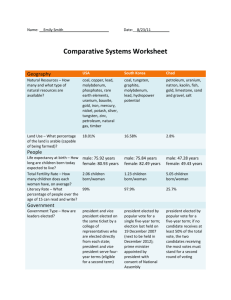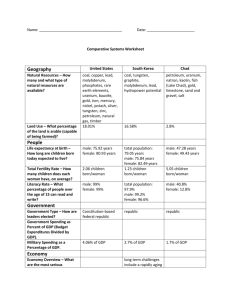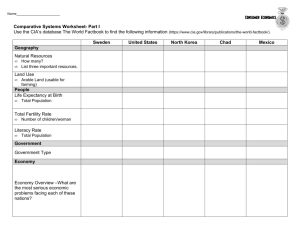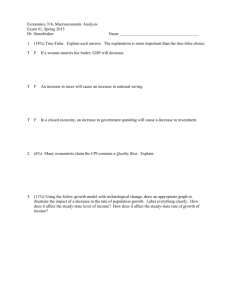Comparative Systems Worksheet
advertisement
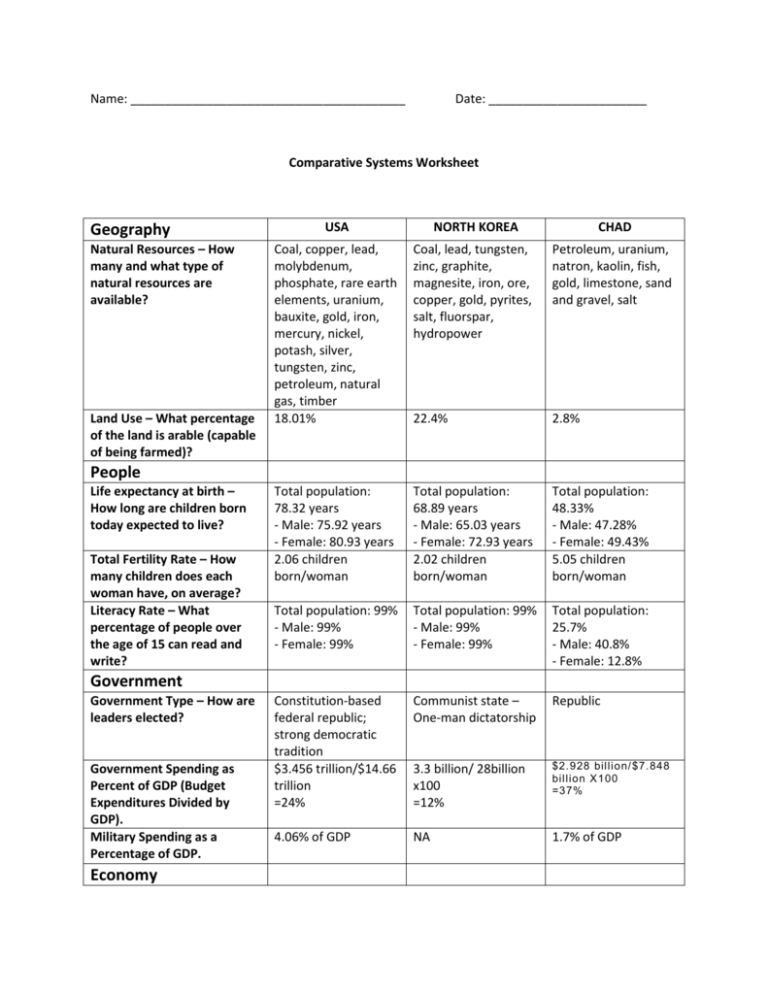
Name: ________________________________________ Date: _______________________ Comparative Systems Worksheet Geography Natural Resources – How many and what type of natural resources are available? Land Use – What percentage of the land is arable (capable of being farmed)? USA NORTH KOREA CHAD Coal, copper, lead, molybdenum, phosphate, rare earth elements, uranium, bauxite, gold, iron, mercury, nickel, potash, silver, tungsten, zinc, petroleum, natural gas, timber 18.01% Coal, lead, tungsten, zinc, graphite, magnesite, iron, ore, copper, gold, pyrites, salt, fluorspar, hydropower Petroleum, uranium, natron, kaolin, fish, gold, limestone, sand and gravel, salt 22.4% 2.8% Total population: 78.32 years - Male: 75.92 years - Female: 80.93 years 2.06 children born/woman Total population: 68.89 years - Male: 65.03 years - Female: 72.93 years 2.02 children born/woman Total population: 48.33% - Male: 47.28% - Female: 49.43% 5.05 children born/woman Total population: 99% - Male: 99% - Female: 99% Total population: 99% - Male: 99% - Female: 99% Total population: 25.7% - Male: 40.8% - Female: 12.8% Constitution-based federal republic; strong democratic tradition $3.456 trillion/$14.66 trillion =24% Communist state – One-man dictatorship Republic 3.3 billion/ 28billion x100 =12% $2. 928 billion/ $7. 848 billion X100 =37% 4.06% of GDP NA 1.7% of GDP People Life expectancy at birth – How long are children born today expected to live? Total Fertility Rate – How many children does each woman have, on average? Literacy Rate – What percentage of people over the age of 15 can read and write? Government Government Type – How are leaders elected? Government Spending as Percent of GDP (Budget Expenditures Divided by GDP). Military Spending as a Percentage of GDP. Economy Economy Overview – What are the most serious economic problems facing each of these three nations? GDP Per Capita – What is the value of goods and services produced per person? Population Below Poverty Line – How many people live in poverty? GDP Composition by Sector – What percentage of GDP is industry and services? Labor Force by Occupation – What percentage of workers is in agriculture? Industries – What are the primary industries? Are they primarily producing for consumer or government consumption? Agriculture Products - What are the primary agricultural goods produced? Facing higher barriers to enter their rivals’ home markets than foreign firms face entering US markets, inadequate investment in economic infrastructure, rapidly rising medical and pension costs of an aging population, sizable trade and budget deficits, stagnation of family income in the lower economic groups $47,200 Large military spending, shortages of spare parts, poor maintenance, underinvestment Landlocked position, high energy costs, history of instability, has to rely on foreign assistance $1,800 $1,600 12% NA 80% Agriculture: 1.1% Industry: 22.1% Services: 76.8% 0.7% Agriculture: 20.7% Industry: 47.8% Services: 31.5% 35% Agriculture: 52% Industry: 7% Services: 41/1% 80% Petroleum, steel, motor vehicles, aerospace, telecommunications, chemicals, electronics, food processing, consumer goods, lumber, mining – Mostly for consumers Military products, machine building, electric power, chemicals; mining (coal, magnesite, iron ore, limestone, graphite, copper, zinc, lead, precious metals), metallurgy; textiles, food – Government consumption Rice, corn, potatoes, soybeans, pulses; cattle, pigs, pork, eggs Oil, cotton, textiles, meatpacking, brewing, natron, soap, cigarettes, construction materials Wheat, corn, other grains, fruits, vegetables, cotton; beef, pork, poultry, dairy products; fish; forest products Cotton, sorghum, millet, peanuts, rice, potatoes, manioc; cattle, sheep, goats, camels Industrial Production Growth Rate Electricity Production Telephones – Main Lines in Use Internet Service Providers Railways Paved Highways Airports with paved Runways 5.3% NA 3% 4.11 trillion kWh 141 million 22.5 billion kWh 1.18 million 100 million kWh 13,000 439 million Total: 224, 792 km 4,374,784 km 5,194 3 Total: 5,242 km 724 km 37 5 NA 267 km 8 Market – Market economy is an economic system where the decisions related to goods and services are done mostly by the private sector to make profit, and the government does not interfere with the businesses much. - Example: USA – USA is an example of market economy because in the US, the government is not really interested about the businesses. There are lots of private businesses aiming to make profits. Command – Command economy, also known as planned economy, is a type of an economic system where the government decides or ‘plans’ what type of businesses can be established for what purpose, for whom and how much to produce. The government has a control over the business market. - Example: North Korea – North Korea has a command economy because there is dictatorship, meaning to say that there is one ultimate power that has control of everything. The government decides on what the type of goods and services are to be produced. The people are provided with all the necessities by the government. Developing economy – Developing economy is not fully developed but not underdeveloped as well. It is found in nations seeking to develop by industrialization. There is a healthy balance between the public sector and the private sector. - Example: Chad – Chad is a poor nation that is slowly developing at the moment. The government doesn’t provide everything for the people, but they do have certain amount of power and there are some private companies as well.
